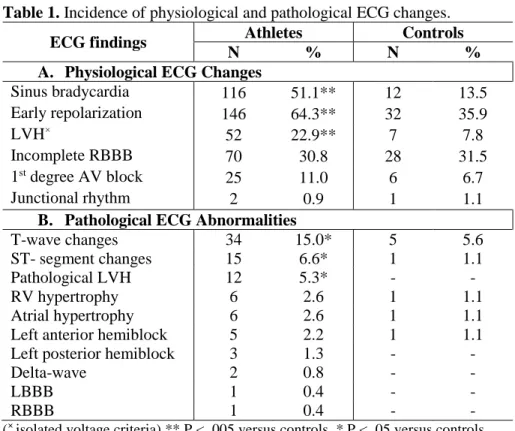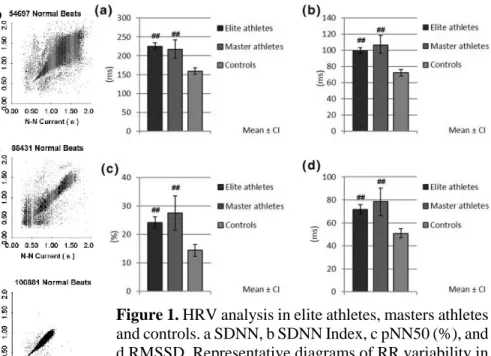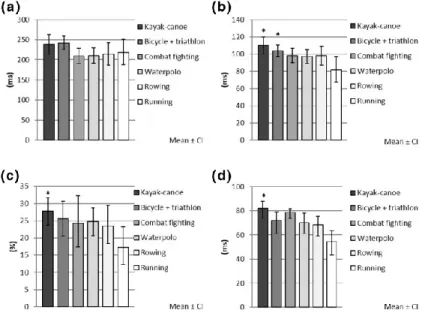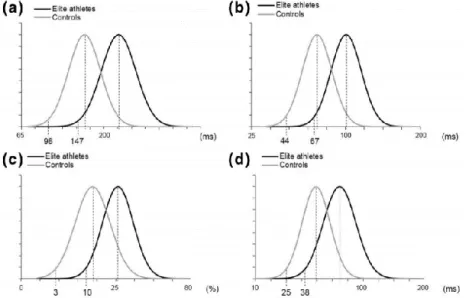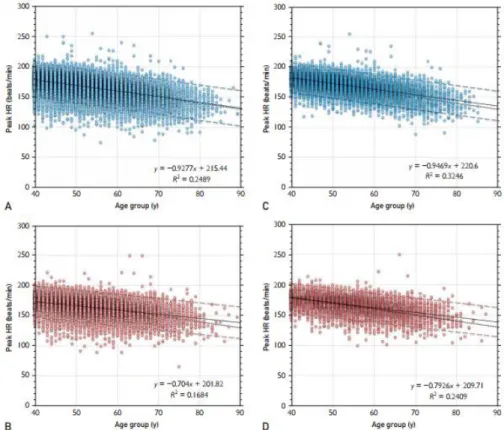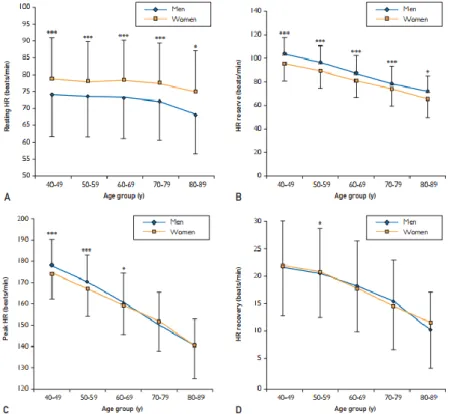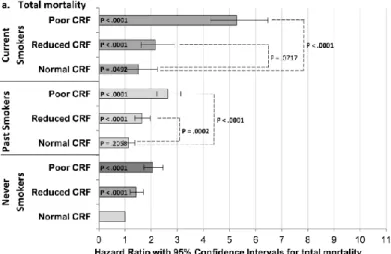0
THE ROLE OF ELECTROCARDIOGRAPHY AND EXERCISE TESTING
IN THE ASSESSMENT OF CARDIOVASCULAR RISK IN ATHLETES AND NON-ATHLETES
PhD Thesis
Nóra Sydó, MD
Doctoral School of Basic and Translational Medicine Semmelweis University
Supervisors: Béla Merkely MD, DSc; Dávid Becker MD, PhD Consultant: Thomas G. Allison PhD, MPH
Official reviewers: Éva Martos MD, PhD, med. habil.
Miklós Zsuzsanna MD, PhD
Head of the Final Examination Committee:
Zoltán Benyó MD, DSc Members of the Final Examination Committee:
József Pucsok, MD, DSc, András Zsáry MD, PhD
Budapest
2018
1
INTRODUCTION
Electrocardiography (ECG) is an essential tool for diagnosis and management of patients with various cardiovascular (CV) diseases. With the development and increased availability of new imaging techniques, however, ECG has lost some of its diagnostic importance. In athletic screening, the usefulness of ECG is also controversial. In athletes, ECG changes are common, and in most cases these reflect benign structural and electrical remodeling of the heart due to physiological adaptation to exercise, a condition often referred to as “athlete’s heart”. However, the differential diagnosis between physiological changes and pathological abnormalities can be challenging. In Hungary, ECG is still a cornerstone of athletic screening.
Its significance is based on simplicity, easy availability, short time to perform and interpret, and high informative value in special cases.
However, the cornerstone is just part of any foundation, so additional test modalities are often necessary. With long-term, 24-hour ECG recordings we may not only catch transient arrhythmias and ischemia, but we can also get useful information about autonomic function and predict CV risk. In case of intact autonomic regulation, simultaneous and opposite changes of sympathetic and parasympathetic activity manifest in beat-to-beat fluctuations of heart rate (HR). Modern Holter monitoring systems are suitable to identify beat-to-beat perturbations of the normal RR intervals, called heart rate variability (HRV) analysis.
On an exercise test, interpretation of the ST segments provides useful for its diagnostic information, but important prognostic value can be gained from variables such as functional aerobic capacity (FAC) and exercise HR responses. The prognostic predictive value of these parameters has been studied in a wide range of CV populations and has proved to be an independent powerful predictor of mortality.
Cigarette smoking has profound effects on health with several disabling and life-shortening consequences. It reduces FAC and impairs the HR response to exercise, which are important early markers of CV risk. Smoking cessation, on the other hand, frequently leads to weight gain and weight- associated comorbidites including hypertension and diabetes. The interplay between smoking status and the predictive exercise factors including FAC and HR recovery are of great potential importance in assessing risk and establishing the benefits of smoking cessation.
2
OBJECTIVES OF OUR STUDIES
The purpose of our studies was to emphasize the importance of ECG in athletic screening, to show the additional diagnostic potential of long-term ECG recording in athletes, to conversely present the predictive value of non- ECG factors on exercise test in an adult referral population and to define the role of FAC and HR responses in predicting risk according to smoking status.
1. Our first aim was to study electrocardiographic adaptation to sports- specific training.
We conducted a detailed prospective observational study of athletes in which we performed ECG analysis
We documented the prevalence of physiological ECG changes, potentially pathological ECG changes in a composite sample of healthy, asymptomatic Hungarian athletes.
2. Our hypothesis was that training adaptation concomit autonomic nervous system adaptation, which can be determined by analysis of HRV during long-term Holter monitoring.
We measured HRV in our prospective cohort of asymptomatic elite and master athletes and controls during Holter ECG monitoring.
Our second aim was to study sport-specific differences in HRV.
Moreover, we targeted to determine normal distribution curves and lower cut-off values for the studied HRV parameters to provide the lower limit of normal athletic values in the elite athletes.
3. Subsequently, we also analyzed a large cohort of adult, non-athletic patients without CV disease, who underwent clinical exercise testing.
Our aim was to determine factors including age, sex, cardiorespiratory fitness (CRF) and comorbidities that affect exercise HR.
After the exclusion of HR modifying factors we aimed to determine exercise HR responses in men and women according to age 4. Finally, using our large exercise testing database with a fully ascertained
total, CV, and cancer mortality during long-term follow-up
We proposed to study the effect of smoking on weight-associated comorbidities and mortality in patients without CV diseases.
We equally sought to determine whether better CRF on a stress test reduces mortality risk in past and current smokers.
3
METHODS
Study Population of Athletic ECG Projects
Healthy asymptomatic elite, non-elite and master athletes and controls were studied. Elite athletes were members of national teams, and they trained more than 10 hours per week. Masters were defined as athletes over 30 years of age who had been former national team members, were still participating in master championships and their amount of training was between 6 and 9 hours per week. Healthy volunteers not participating in competitive sports composed the control group recruited from employees of Semmelweis University, mainly medical students and residents. Their physical activity was less than 3–4 hours per week according to the questionnaire mentioned above. The upper limit of training time during Holter monitoring was maximum 2 hours. Individuals were excluded if they had any history of heart disease, diabetes, or still existing systemic disease.
Study Population of Exercise ECG Projects
Patients who underwent exercise treadmill testing between September 21, 1993, and December 20, 2010, were identified retrospectively using the Mayo Integrated Stress Center (MISC) database in Rochester, MN, USA.
For our exercise HR project we included patients aged 40 to 89 years who had performed non-imaging treadmill tests according to the Bruce protocol.
Exclusion criteria to define our preliminary cohort were: (1) documented history of known CV disease, including ischemic heart diseases, heart failure, cardiac surgery, structural or valvular heart diseases, major arrhythmias, defibrillator or pacemaker, congenital heart diseases, cerebrovascular diseases, and peripheral vascular diseases; (2) use of any HR attenuating or rhythm-modifying agents, including beta blockers, calcium channel blockers, sotalol, and amiodarone, at the time of the exercise test;
(3) patients younger than 40 years because reasons for exercise testing in younger patients were different and the number of younger patients was relatively small; (4) the test was not symptom limited but stopped because of ST changes, major arrhythmias, or abnormal BP response; and (5) for patients who underwent multiple exercise tests during the study period, only the initial exercise test was included. For our smoking project the study population was basically the same, but we included patients older than 30 years and we did not exclude patients using HR attenuating or rhythm- modifying drugs.
4
Demographic and relevant clinical characteristics extracted from the database included hypertension (defined by previous diagnosis or receiving antihypertension medication), diabetes mellitus (defined by previous diagnosis), obesity (defined as body mass index of 30 kg/m2), and current smoking. Smoking status was defined according to the Centers for Disease Control (CDC) definitions. Never smokers have not smoked 100 cigarettes in their lifetime and do not smoke now. A smoker was considered past smoker if smoked at least 100 cigarettes but does not smoke any now.
Current smokers have smoked at least 100 cigarettes in their lifetime and currently smoke. We also identified patients who were grossly unfit or unable to exercise adequately as having a FAC of < 80%. Patients were divided into 3 groups by smoking status, and then these groups were sub- divided into 3 groups according to CRF based on FAC on the exercise test:
poor CRF < 80%, reduced CRF 80 – 99%, normal CRF ≥ 100%.
Ethical approval for the Hungarian research projects was obtained from the Central Ethics Committee of Hungary (13697-1/2011-EKU[443/PI/11.]) and all participants gave informed consent. Exercise ECG investigations were a retrospective database studies approved by the Institutional Review Board of Mayo Clinic, Rochester, Minnesota. Subjects who did not consent to have their data used in research under Minnesota Statue (§144.335) were excluded.
Measurements
Athletes
Resting 12- lead ECG
Standard resting 12-lead ECGs were recorded (BTL – 08MT). Detailed ECG analysis was performed using the 2010 recommendations for ECG interpretation of athletes by the European Society of Cardiology.
Holter ECG
Three-channel Holter ECG screening was applied (ScottCare Cardioview DxSuite, USA) using modified V5, V1 and III leads. Automatic HRV analysis was carried out using software HolterCare ver. 10.2.2. After the automatic analysis, all recordings were examined by a physician to verify premature beats and artifacts. During the test the participants were asked to do their daily routine as usual, including training, food intake and sleeping.
Holter ECG Variables
Short- and long-term time-domain parameters were studied excluding premature and artifacts beat as follows: (1) The standard deviation of all
5
normal-to-normal intervals (SDNN), which is a global index of HRV reflecting all circadian changes during the whole recording period. It characterizes the overall variability of HR, which means it can be influenced both by parasympathetic and sympathetic stimulation. (2) The mean of the 5-min standard deviation of the normal-to-normal intervals (SDNN Index), which measures the variability of 5-min cycles. It integrates the fast and intermediate components of HRV. (3) The square root of the mean squared differences between adjacent NN intervals (RMSSD) and (4) the percentage of successive normal-to-normal interval differences that are greater than 50 ms (pNN50) primarily reflects the parasympathetically mediated short-term alterations of autonomic tone.
Non-Athletes
Exercise Treadmill Test Protocol
Symptom-limited treadmill exercise testing was performed using the standard Bruce protocol according to the ACC/AHA guidelines. Symptoms, BP, HR, rating of perceived exertion (RPE), and workload were electronically entered into the database during the final minute of each stage of exercise, peak exercise, 1 and 3 minutes of active recovery, and 6 minutes after peak exercise in passive recovery.
Exercise Treadmill Test Variables
Exercise data used in analyses included percentage of predicted FAC calculated from published equations from our laboratory with adjustment for age and sex. Patients with an FAC of 80% were considered either grossly unfit or unable to exercise adequately to achieve peak HR. A positive exercise ECG was defined by standard criteria. An abnormal exercise ECG was defined as any test with 1.0 mm ST deviation irrespective of whether the resting ST segments were normal. Resting HR obtained in the standing position and peak HR were identified and used to calculate the HR reserve (difference between peak and resting HR). The HR recovery was defined as peak HR minus HR at 1 minute of active recovery (1.7 miles per hour/0%
grade) and was considered abnormal if it was less than 12 beats/min.
Outcomes
Outcomes were taken from Mayo Clinic patient records and the Minnesota Death Index, which was reviewed in March, 2016. A death was considered to be CV-related if a CV condition was included among the first three listed causes in the Minnesota Death Index. CV mortality data was classified using International Classification of Diseases (ICD) 9 and ICD 10 codes.
6
Statistical analyses
Athletes (Research Aims 1-2)
Age was compared using 2-sided t-test, while gender and ECG characteristics were compared using Fisher’s exact test. Differences between groups were evaluated using one-way analysis of variance. Differences between HRV parameters of the studied groups were assessed after normalizing square-root transformation by analysis of covariance with age as a covariate. Pairwise comparisons of age-corrected means were performed using Tukey–Kramer post hoc test. Normal distribution curves were fitted by square root transformation, and lower cut-off values were determined at 5 %.
Non-Athletes (Research Aims 3-4)
Statistical analyses proceeded in 2 parts: (1) create a preliminary cohort of patients without CV disease or drugs affecting HR and identify the comorbidities that influence peak HR and (2) determine the relationship between exercise HR and sex in a pure cohort with those comorbidities eliminated. Baseline characteristics and exercise test variables were compared by sex using 2-sided t tests for continuous variables and the chi- square test of continuity for categorical variables. Analysis of variance using the general linear model was used to identify factors affecting peak HR with adjustment for sex and age. Factors included in the model were diabetes, hypertension, hyperlipidemia, obesity and unfit status (FAC<.05).
Patient characteristics, outcomes, and exercise data were also analyzed by smoking status. Differences among continuous variables were assessed by analysis of variance under the general linear model with multiple comparisons handled by Tukey’s method, while logistic regression was used to determine differences in discrete variables by smoking status. For the primary analysis of smoking-related comorbidities - diabetes, hypertension, and obesity, logistic regression models were adjusted for age and sex.
Differences among smoking groups in total, CV, and cancer death were tested using Cox proportional hazards regression with adjustment for age, sex and the three comorbidities. Finally, we also analyzed mortality by smoking status and level of CRF. Never smokers with normal CRF formed the referent group, then the differences between hazard ratios were tested within the groups.
7
RESULTS
ELECTROCARDIOGRAPHIC FINDINGS Study Population
Standard ECG screening was applied in 227 Caucasian athletes (male:
180, age: 27.2 ± 8.7). Elite athletes (n = 155) including several members of the Hungarian Olympic team, masters (n = 16), non-elite athletes (n = 56) and 89 controls (male: 57, age: 28.1 ± 6.8) were examined. No difference was found in age between athletes and controls, but the rate of female gender was higher in controls. Athletes performed various sports, mainly kayaking and canoeing, water polo and rowing.
Training-related Physiological ECG Findings
According to our results, almost all athlete had at least one training- related ECG sign. Sinus bradycardia, early repolarization and isolated voltage criteria of LVH were common and found more often in athletes compared to the control group (Table 1/A).
Training-unrelated Pathological ECG Findings
Some ECG signs considered pathological such as repolarization changes including T-wave abnormalities, ST-segment changes and signs of pathological LVH were found more often in athletes compared to the control group (Table I/B). In 15% of the athletes, we recorded T-wave inversion classified as pathological. In most cases, T-wave inversion occurred in adjacent inferior or V1–V3 leads. LVH considered pathological – mostly associated with T-wave inversion – was presented in more than 5% of the athletes while in no controls.
All athletes who had any pathological ECG abnormality underwent
our detailed cardiology exam including echocardiography and cardiac
MR. We did not find any stuctural heart disease, therefore no athlete
was disqualified.
8
Table 1. Incidence of physiological and pathological ECG changes.
ECG findings Athletes Controls
N % N %
A. Physiological ECG Changes
Sinus bradycardia 116 51.1** 12 13.5
Early repolarization 146 64.3** 32 35.9
LVH× 52 22.9** 7 7.8
Incomplete RBBB 70 30.8 28 31.5
1st degree AV block 25 11.0 6 6.7
Junctional rhythm 2 0.9 1 1.1
B. Pathological ECG Abnormalities
T-wave changes 34 15.0* 5 5.6
ST- segment changes 15 6.6* 1 1.1
Pathological LVH 12 5.3* - -
RV hypertrophy 6 2.6 1 1.1
Atrial hypertrophy 6 2.6 1 1.1
Left anterior hemiblock 5 2.2 1 1.1
Left posterior hemiblock 3 1.3 - -
Delta-wave 2 0.8 - -
LBBB 1 0.4 - -
RBBB 1 0.4 - -
(× isolated voltage criteria) ** P < .005 versus controls, * P < .05 versus controls
9
HOLTER ECG FINDINGS Analysis by Study Intesity
The Holter ECG screening was applied in 138 athletes – 121 elite and 17 masters – (male 110, age 28.4 ± 8.3, recording time 21.3 ± 3.0 h) and 100 healthy controls. No difference was found in recording time among the studied groups. Masters athletes were older than all the other groups. The ratio of males was higher in athlete groups compared to controls. All studied HRV parameters were higher in elite athletes compared to controls [SDNN (CI) 225.3 (216.2–234.5) versus 158.6 (150.2–167.1) ms (e.s.:1.43); SDNN Index (CI) 99.6 (95.6–103.7) versus 72.4 (68.7–76.2) ms (e.s.:1.32); pNN50 (CI) 24.2 (22.2–26.3) versus 14.4 (12.7–16.3) % (e.s.: 0.96); RMSSD (CI) 71.8 (67.6–76.2) versus 50.8 (46.9–54.8) ms (e.s.:0.96); P <.001] (Figure 1).
All HRV parameters of masters were higher than controls. No difference could be found between HRV values of elite athletes and masters. No effect of gender on the studied HRV parameters could be established.
Figure 1. HRV analysis in elite athletes, masters athletes and controls. a SDNN, b SDNN Index, c pNN50 (%), and d RMSSD. Representative diagrams of RR variability in individuals under different intensity training.
## P < .001 versus control
10
Analysis by Sport
Subgroup analysis by sports was carried out in cyclists + triathlonists (n=20), canoe and kayak paddlers (n=42), waterpolo players (n=26), rowers (n=27), runners (n=13) and combat fighters (kick-boxers and thai boxers, n=10).
Runners were older than all other studied sport groups as most of them were ultramarathon runners. The ratio of females was higher in the waterpolo group compared to canoe and kayak paddlers, rowers and cyclists + triathlonists. All studied age-corrected HRV parameters were the highest in canoe and kayak paddlers and cyclists + triathlonists and the lowest in runners (Figure 2). Canoe and kayak paddlers had higher SDNN Index:
110.0 (103.1–117.2) versus 81.6 (71.0–92.9) ms (e.s.:1.33), pNN50: 27.7 (24.2–31.4) versus 17.2 (12.5–22.7) ms (e.s.:1.00), and RMSSD values: 81.9 (74.1–88.1) versus 54.4 (42.3–63.7) ms (e.s.:1.15), cyclists + triathlonists had higher SDNN index value than runners 103.8 (94.2–114.0) versus 81.6 (71.0–92.9) ms (e.s.:1.05).
Figure 2. Subgroup analysis by sport activities. a SDNN, b SDNN Index, c pNN50 (%), and d RMSSD. * P < 0.05 versus. running
11
Comparison of Lower Cut-off Values
In the controls, the 5 % lower cut-off values were comparable to the published normal values (SDNN: 97.6 ms, SDNN Index 44.1 ms, pNN50 2.6
%, RMSSD 24.6 ms). On the contrary, the normal distribution curves of all studied HRV parameters shifted to the right with substantially higher cut-off values in elite athletes (SDNN 147.4 ms, SDNN Index 66.6 ms, pNN50 9.7
%, RMSSD 37.9 ms (Figure 3).
Figure 3. Normal distribution curves and lower cut-off values of elite athletes and controls. a SDNN, b SDNN Index, c pNN50 (%), and d RMSSD.
12
EXERCISE TEST RESULTS Study Population
Our cohort was derived from adults consecutively referred for exercise stress testing at Mayo Clinic, Rochester, between September 21, 1993, and December 20, 2010. We initially reviewed 105,220 exercise tests on 79,769 unique patients. Of these, 37,010 met preliminary inclusion and exclusion criteria.
Peak Heart Rate by Age in Men versus Women in the Preliminary Clinical Cohort
To further examine the relationship between peak HR and age in men versus women, we separately plotted peak HR by age for men and women in the preliminary cohort of 37,010 patients (Figures 4, A and B). Using linear regression, lines predicting peak HR by age are shown in Figure 4, along with 90% CIs and the traditional line depicting 220 minus age. Note a large variance around the regression line in both sexes. The regression line more closely approximated 220 minus age in terms of both intercept and slope for men versus women.
Analysis of Factors Affecting Peak Heart Rate
Using multivariate regression on the preliminary cohort, comorbidities significantly affecting peak HR included poor exercise capacity (beta coefficient = - 11 beats/min), current smoking (-6 bpm), diabetes (-3 bpm), and obesity (-2 bpm). We excluded patients with these comorbidities to form the pure cohort of 19,013 patients (51.3% of full cohort). Peak HR was again plotted against age for men and women separately in Figures 4, C and D.
The distribution of peak HR by age became tighter (with improved R2) after eliminating patients with modifying risk factors, and the regression lines more closely approximated the traditional 220 minus age formula. For men, the regression line in our pure cohort was peak HR = 221 - 0.95 x age. For women, it was peak HR = 210 - 0.79 x age, which was still substantially different from the traditional 220 minus age formula. Comparing the relationship of peak HR to age between men with women in our pure cohort, both the regression slopes and intercepts were different at P<.0001.
13
Figure 4. Scatter plot diagrams of the peak HR on the preliminary, unadjusted clinical cohort by age in men (A) and women (B), and on the final, adjusted clinical cohort in men (C) and women (D). Results of linear regression are shown as continuous lines, with 90% CIs shown as broken lines, whereas the traditional formula of 220 minus age is shown as dotted lines.
14
Exercise Test Parameters by Age in Men versus Women in the Pure Clinical Cohort
We divided the final data set into 5 age groups to analyze the effect of aging on HR parameters in men and women. All exercise HR parameters showed an inverse linear relationship to age in both sexes (Figure 5). Resting HR was higher in women than in men in all age groups. The HR reserve was lower in women than in men and showed continuously decreasing differences by successive age groups. In the 40 to 49 and 50 to 59 years age groups, significant differences were found in peak HR, but the curves crossed at the 60 to 69 years age group, and so older women had slightly higher peak HR than did men. Differences in HR recovery were small on comparing men and women, with a significant difference only in the age group 50 to 59
years.
Figure 5. Resting HR (A), HR reserve (B), peak HR (C), and HR recovery (D) by age in men versus women in the final cohort. Data points represent mean ± SD. Significance levels: *** P <.05, * P < .05.
15
Exercise Testing and Mortality Risk
Comorbidities by Smoking StatusFor the next step of the analysis, logistic regression with age and sex adjustment was applied on comorbidities by smoking status to determine the risk of the presence of diabetes, obesity and hypertension according to smoking status (Figure 6). Past smokers had a greater prevalence of obesity, hypertension, and diabetes compared to never smokers. Current smokers did not show an increased prevalence of these comorbidities compared to never smokers.
Figure 6. Odds ratios with 95% confidence intervals for comorbidities adjusted for age and sex. Never smokers was the referent group. P values indicate significance of the hazard ratios compared to never smokers.
Outcomes
There were 1749 deaths (9.0 %) over a mean follow-up of 12.4 ± 5.0 years.
Consistent with exclusion of baseline CVD and residence in a state (Minnesota) with overall low CV death rates, cancer death was actually more common than CV deaths in our study group. Mortality in the never smokers (referent) was 6.2%. Figure 7 shows the Cox regression analysis for total, CV and cancer mortality adjusted for age, sex, diabetes, hypertension and obesity.
16
Figure 7. Hazard ratios with 95% confidence intervals for total, CV and cancer death adjusted for age, sex, diabetes, obesity and hypertension. Never smokers was the referent group. P values indicate significance of the hazard ratios compared to never smokers.
Never smokers formed the referent group for all analyses. Total, CV and cancer death rates were only slightly increased in past smokers versus never smokers but were much higher in current smokers. There was no overlap between confidence intervals in any group. The hazard ratio was the highest for CV mortality in current smokers (2.95; 95% CI: 2.3 – 3.8). We analyzed the effect of CRF on mortality in the smoking groups (Figure 8). Total mortality in never, past and current smokers was inversely related to CRF as shown on Figure 8. Never smokers with normal CRF (FAC ≥ 100%) formed the referent group for the first part of the analysis; then we performed the comparisons within smoking groups using the normal CRF for each specific smoking group as the referent. Compared to the normal CRF/never smokers, all groups except the normal CRF/past smokers showed increased risk of all mortality. The current smokers with poor CRF had the highest mortality (hazard ratio: 5.3 with 95% confidence limits [4.3 – 6.5]).
17
Figure 8. Hazard ratios with 95% confidence intervals for total mortality (3a), CV (CV) mortality (3b), and cancer mortality (3c) according to smoking status and level of CRF (CRF) adjusted for age, sex, diabetes, hypertension, and obesity. P values in the bars indicate the significance of hazard ratios compared to referent group. Differences within the smoking groups indicated by dashed lines. P values indicate significance of the hazard ratios compared to normal CRF groups in never, past and current smokers.
CRF = cardiorespiratory fitness
We did a secondary analysis using all never smokers as a referent group (not showing on the figure) and found that fit (CRF ≥ 100%) current smokers did not have increased mortality versus all never smokers (HR = 0.98; 99% CI:
0.67 - 1.50), and mortality of fit past smokers was actually lower versus all never smokers (HR = 0.80; 99% CI: 0.64 - 0.95). We analyzed CV and cancer mortality as well. The pattern of cancer mortality was quite similar compared to total mortality, but the effect of CRF was more pronounced regarding the CV mortality between each group. The hazard ratio for total mortality in current smokers was 5.3 with 95% confidence limits [4.3 – 6.5], while the hazard ratio for CV mortality in current smokers was 7.1 with 95%
confidence limits [4.9 – 10.3].
18
CONCLUSIONS
Our investigations have covered a broad approach to the clinical problem of establishing CV risk. The continuum of individuals studied ranges from young athletes and master athletes with high levels of CV fitness, who would mostly be at the lowest possible risk level if not for their high intensity training and competitive performance, all the way to adults who are current smokers with very much reduced levels of CRF and at very high risk for total and CV mortality. A number of evaluative techniques – all involving some aspect of ECG – have been explored: the simple 12-lead resting ECG; long- term ECG recordings by Holter monitoring with special analysis of HRV;
and exercise ECG. Although imaging now dominates the practice of cardiology, we show that there continues to be great power in the simple things – the resting ECG, the pattern of response of the HR, and the ability to perform aerobic exercise.
According to our results, the athletes’ ECG data showed a significant physiological electrical and structural adaptation but in some cases potentially pathological abnormalities may be revealed. In our study of a composite sample of asymptomatic Hungarian athletes, we have found no underlying structural heart disease either in individuals with ECG abnormalities. However, with a thorough evaluation of ECG, we could recognize athletes as being at a potentially higher risk, therefore we suggest regular CV follow-up. Our study is a representative sample of Hungarian athletic ECG changes, therefore we believe that an exact definition and widespread knowledge of athletic ECG is essential in early recognition of high risk athletes.
Athletic adaptation can also be investigated with long-term ECG recording.
On a routine Holter ECG recording we can get important information about the status of the autonomic nervous system. In athletes, long-term time- domain parameters of HRV were proved to be higher compared to controls.
This indicates that autonomic adaptation is a part of athletic adaptation reflecting a dominant parasympathetic tone. Moreover, these parameters vary according to sports modality referring to the role of autonomic system in the sport-specific adaptation of the heart. According to our findings, autonomic adaptation of athletes is permanent, because the elevated HRV values remain unchanged in master athletes. As we have determined normal athletic values, therefore using our lower cut off values may also detect athletes at high CV risk based on decreased autonomic adaptation.
19
ECG recording during exercise testing is another important method of risk assessment. In our studies we focused on the prognostic parameters from the exercise test, and we have also identified the clinical factors which modify these prognostic parameters. HR responses to exercise are age and sex related. Women have higher resting HR rate, lower HR reserve and lower peak HR compared to men. Observing these sex differences brought up the idea that predicted equation in women may have to be different. In our large cohort, after eliminating factors negatively affecting peak HR, the equation predicting peak HR in men was nearly identical to the traditional formula but peak HR in women had a lower intercept and decreased more slowly with age. A separate formula for peak HR in women seems to be appropriate.
Exercise HR responses are different in many pathological conditions. In our research we have focused on the effects of smoking. Although past smokers showed higher rates of comorbidities (obesity, diabetes, hypertension, and low CRF), their mortality was only mildly increased compared to never smokers. Current smoking, however, carried a high mortality risk despite lack on an increase in CV comorbidites versus never smokers. These data suggest that quitting smoking is beneficial despite increased comorbidities.
Exercise may potentially mitigate the risk of both comorbidities and death in those who quit smoking. Overall, we can conclude that exercise testing is an important diagnostic method and it has potential important prognostic value to detect patients at high risk.
20
Publications directly related to the PhD dissertation
1. Sydó N, Abdelmoneim SS, Mulvagh SL, Merkely B, Gulati M, Allison TG. (2014) Relationship between exercise heart rate and age in men versus women. Mayo Clin Proc, 89(12):1664-72.
IF: 6.262
2. Sydó N*, Kiss O*, Vargha P, Édes E, Merkely G, Sydó T, Merkely B.
(2015) Prevalence of physiological and pathological electro- cardiographic fndings in Hungarian athletes. Acta Physiol Hung, 102(2):228-37.
IF: 0.734 * Equal authorship
3. Sydó N*, Kiss O*, Vargha P, Vágó H, Czimbalmos Cs, Édes E, Zima E, Apponyi Gy, Merkely G, Sydó T, Becker D, Allison TG, Merkely B.
(2016) Detailed heart rate variability analysis in athletes. Clin Auton Res, 26(4):245-52.
IF: 1.257 * Equal authorship
4. Sydó N*, Merkely B*, Gonzalez Carta K, Becker D, Hussain N, Murphy JG, Sydó T, Lopez-Jimenez F, Allison TG. (2018) Effect of cardiorespiratory fitness on comorbidities and mortality in never, past and current smokers. Accepted in Am J Cardiol.
IF: 3.171 * Equal authorship
Publications not related to the PhD dissertation
1. Hussain N, Gersh BJ, Gonzalez Carta K, Sydó N, Lopez-Jimenez F, Kopecky SL, Thomas RJ, Asirvatham SJ, Allison TG. (2018) Impact of cardiorespiratory fitness on frequency of atrial fibrillation, stroke, and all-cause mortality. Am J Cardiol, 121(1):41-9.
IF: 3.398
2. Sydó N*, Sydó T*, Merkely B, Carta KG, Murphy JG, Lopez-Jimenez F, Allison TG. (2016) Impaired heart rate response to exercise in diabetes and its long-term significance. Mayo Clin Proc, S0025- 6196(15)00892-7.
IF: 6.262 * Equal authorship
